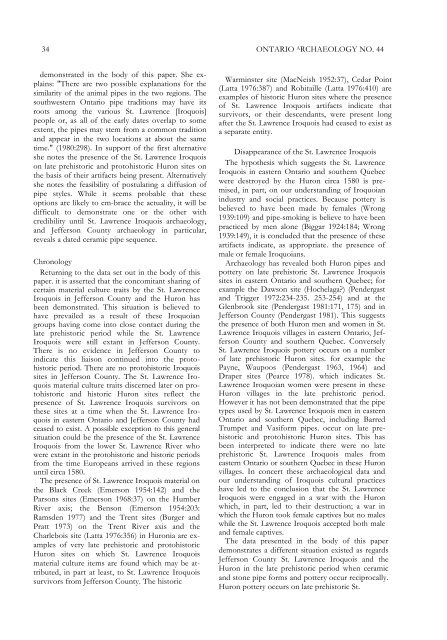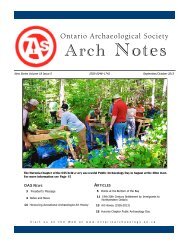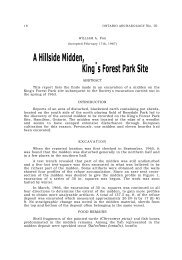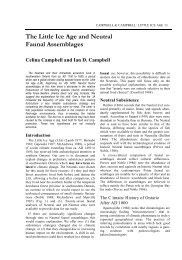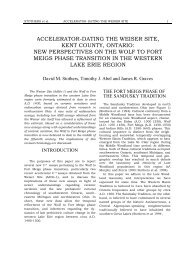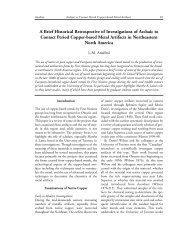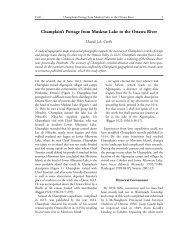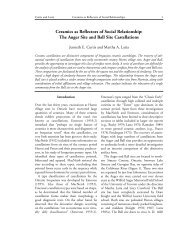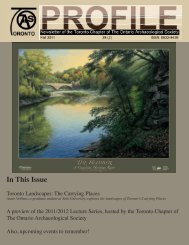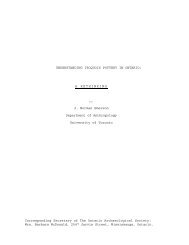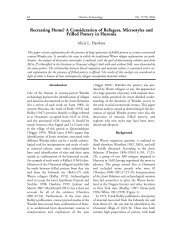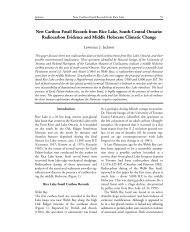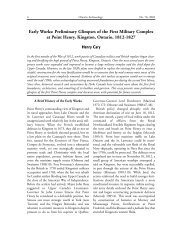Huron-St. Lawrence Iroquois Relations in the Terminal Prehistoric ...
Huron-St. Lawrence Iroquois Relations in the Terminal Prehistoric ...
Huron-St. Lawrence Iroquois Relations in the Terminal Prehistoric ...
You also want an ePaper? Increase the reach of your titles
YUMPU automatically turns print PDFs into web optimized ePapers that Google loves.
34 ONTARIO A RCHAEOLOGY NO. 44demonstrated <strong>in</strong> <strong>the</strong> body of this paper. She expla<strong>in</strong>s:"There are two possible explanations for <strong>the</strong>similarity of <strong>the</strong> animal pipes <strong>in</strong> <strong>the</strong> two regions. Thesouthwestern Ontario pipe traditions may have itsroots among <strong>the</strong> various <strong>St</strong>. <strong>Lawrence</strong> [<strong>Iroquois</strong>]people or, as all of <strong>the</strong> early dates overlap to someextent, <strong>the</strong> pipes may stem from a common traditionand appear <strong>in</strong> <strong>the</strong> two locations at about <strong>the</strong> sametime." (1980:298). In support of <strong>the</strong> first alternativeshe notes <strong>the</strong> presence of <strong>the</strong> <strong>St</strong>. <strong>Lawrence</strong> <strong>Iroquois</strong>on late prehistoric and protohistoric <strong>Huron</strong> sites on<strong>the</strong> basis of <strong>the</strong>ir artifacts be<strong>in</strong>g present. Alternativelyshe notes <strong>the</strong> feasibility of postulat<strong>in</strong>g a diffusion ofpipe styles. While it seems probable that <strong>the</strong>seoptions are likely to em-brace <strong>the</strong> actuality, it will bedifficult to demonstrate one or <strong>the</strong> o<strong>the</strong>r withcredibility until <strong>St</strong>. <strong>Lawrence</strong> <strong>Iroquois</strong> archaeology,and Jefferson County archaeology <strong>in</strong> particular,reveals a dated ceramic pipe sequence.ChronologyReturn<strong>in</strong>g to <strong>the</strong> data set out <strong>in</strong> <strong>the</strong> body of thispaper. it is asserted that <strong>the</strong> concomitant shar<strong>in</strong>g ofcerta<strong>in</strong> material culture traits by <strong>the</strong> <strong>St</strong>. <strong>Lawrence</strong><strong>Iroquois</strong> <strong>in</strong> Jefferson County and <strong>the</strong> <strong>Huron</strong> hasbeen demonstrated. This situation is believed tohave prevailed as a result of <strong>the</strong>se Iroquoiangroups hav<strong>in</strong>g come <strong>in</strong>to close contact dur<strong>in</strong>g <strong>the</strong>late prehistoric period while <strong>the</strong> <strong>St</strong>. <strong>Lawrence</strong><strong>Iroquois</strong> were still extant <strong>in</strong> Jefferson County.There is no evidence <strong>in</strong> Jefferson County to<strong>in</strong>dicate this liaison cont<strong>in</strong>ued <strong>in</strong>to <strong>the</strong> protohistoricperiod. There are no protohistoric <strong>Iroquois</strong>sites <strong>in</strong> Jefferson County. The <strong>St</strong>. <strong>Lawrence</strong> <strong>Iroquois</strong>material culture traits discerned later on protohistoricand historic <strong>Huron</strong> sites reflect <strong>the</strong>presence of <strong>St</strong>. <strong>Lawrence</strong> <strong>Iroquois</strong> survivors on<strong>the</strong>se sites at a time when <strong>the</strong> <strong>St</strong>. <strong>Lawrence</strong> <strong>Iroquois</strong><strong>in</strong> eastern Ontario and Jefferson County hadceased to exist. A possible exception to this generalsituation could be <strong>the</strong> presence of <strong>the</strong> <strong>St</strong>. <strong>Lawrence</strong><strong>Iroquois</strong> from <strong>the</strong> lower <strong>St</strong>. <strong>Lawrence</strong> River whowere extant <strong>in</strong> <strong>the</strong> protohistoric and historic periodsfrom <strong>the</strong> time Europeans arrived <strong>in</strong> <strong>the</strong>se regionsuntil circa 1580.The presence of <strong>St</strong>. <strong>Lawrence</strong> <strong>Iroquois</strong> material on<strong>the</strong> Black Creek (Emerson 1954:142) and <strong>the</strong>Parsons sites (Emerson 1968:37) on <strong>the</strong> HumberRiver axis; <strong>the</strong> Benson (Emerson 1954:203:Ramsden 1977) and <strong>the</strong> Trent sites (Burger andPratt 1973) on <strong>the</strong> Trent River axis and <strong>the</strong>Charlebois site (Latta 1976:356) <strong>in</strong> <strong>Huron</strong>ia are examplesof very late prehistoric and protohistoric<strong>Huron</strong> sites on which <strong>St</strong>. <strong>Lawrence</strong> <strong>Iroquois</strong>material culture items are found which may be attributed,<strong>in</strong> part at least, to <strong>St</strong>. <strong>Lawrence</strong> <strong>Iroquois</strong>survivors from Jefferson County. The historicWarm<strong>in</strong>ster site (MacNeish 1952:37), Cedar Po<strong>in</strong>t(Latta 1976:387) and Robitaille (Latta 1976:410) areexamples of historic <strong>Huron</strong> sites where <strong>the</strong> presenceof <strong>St</strong>. <strong>Lawrence</strong> <strong>Iroquois</strong> artifacts <strong>in</strong>dicate thatsurvivors, or <strong>the</strong>ir descendants, were present longafter <strong>the</strong> <strong>St</strong>. <strong>Lawrence</strong> <strong>Iroquois</strong> had ceased to exist asa separate entity.Disappearance of <strong>the</strong> <strong>St</strong>. <strong>Lawrence</strong> <strong>Iroquois</strong>The hypo<strong>the</strong>sis which suggests <strong>the</strong> <strong>St</strong>. <strong>Lawrence</strong><strong>Iroquois</strong> <strong>in</strong> eastern Ontario and sou<strong>the</strong>rn Quebecwere destroyed by <strong>the</strong> <strong>Huron</strong> circa 1580 is premised,<strong>in</strong> part, on our understand<strong>in</strong>g of Iroquoian<strong>in</strong>dustry and social practices. Because pottery isbelieved to have been made by females (Wrong1939:109) and pipe-smok<strong>in</strong>g is believe to have beenpracticed by men alone (Biggar 1924:184; Wrong1939:149), it is concluded that <strong>the</strong> presence of <strong>the</strong>seartifacts <strong>in</strong>dicate, as appropriate. <strong>the</strong> presence ofmale or female Iroquoians.Archaeology has revealed both <strong>Huron</strong> pipes andpottery on late prehistoric <strong>St</strong>. <strong>Lawrence</strong> <strong>Iroquois</strong>sites <strong>in</strong> eastern Ontario and sou<strong>the</strong>rn Quebec; forexample <strong>the</strong> Dawson site (Hochelaga?) (Pendergastand Trigger 1972:234-235. 253-254) and at <strong>the</strong>Glenbrook site (Pendergast 1981:171, 175) and <strong>in</strong>Jefferson County (Pendergast 1981). This suggests<strong>the</strong> presence of both <strong>Huron</strong> men and women <strong>in</strong> <strong>St</strong>.<strong>Lawrence</strong> <strong>Iroquois</strong> villages <strong>in</strong> eastern Ontario, JeffersonCounty and sou<strong>the</strong>rn Quebec. Conversely<strong>St</strong>. <strong>Lawrence</strong> <strong>Iroquois</strong> pottery occurs on a numberof late prehistoric <strong>Huron</strong> sites. for example <strong>the</strong>Payne, Waupoos (Pendergast 1963, 1964) andDraper sites (Pearce 1978). which <strong>in</strong>dicates <strong>St</strong>.<strong>Lawrence</strong> Iroquoian women were present <strong>in</strong> <strong>the</strong>se<strong>Huron</strong> villages <strong>in</strong> <strong>the</strong> late prehistoric period.However it has not been demonstrated that <strong>the</strong> pipetypes used by <strong>St</strong>. <strong>Lawrence</strong> <strong>Iroquois</strong> men <strong>in</strong> easternOntario and sou<strong>the</strong>rn Quebec, <strong>in</strong>clud<strong>in</strong>g BarredTrumpet and Vasiform pipes. occur on late prehistoricand protohistoric <strong>Huron</strong> sites. This hasbeen <strong>in</strong>terpreted to <strong>in</strong>dicate <strong>the</strong>re were no lateprehistoric <strong>St</strong>. <strong>Lawrence</strong> <strong>Iroquois</strong> males fromeastern Ontario or sou<strong>the</strong>rn Quebec <strong>in</strong> <strong>the</strong>se <strong>Huron</strong>villages. In concert <strong>the</strong>se archaeological data andour understand<strong>in</strong>g of <strong>Iroquois</strong> cultural practiceshave led to <strong>the</strong> conclusion that <strong>the</strong> <strong>St</strong>. <strong>Lawrence</strong><strong>Iroquois</strong> were engaged <strong>in</strong> a war with <strong>the</strong> <strong>Huron</strong>which, <strong>in</strong> part, led to <strong>the</strong>ir destruction; a war <strong>in</strong>which <strong>the</strong> <strong>Huron</strong> took female captives but no maleswhile <strong>the</strong> <strong>St</strong>. <strong>Lawrence</strong> <strong>Iroquois</strong> accepted both maleand female captives.The data presented <strong>in</strong> <strong>the</strong> body of this paperdemonstrates a different situation existed as regardsJefferson County <strong>St</strong>. <strong>Lawrence</strong> <strong>Iroquois</strong> and <strong>the</strong><strong>Huron</strong> <strong>in</strong> <strong>the</strong> late prehistoric period when ceramicand stone pipe forms and pottery occur reciprocally.<strong>Huron</strong> pottery occurs on late prehistoric <strong>St</strong>.


